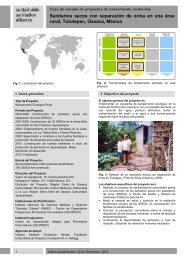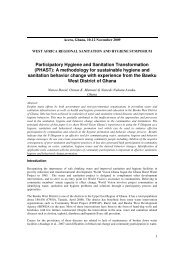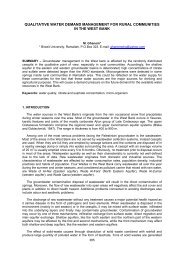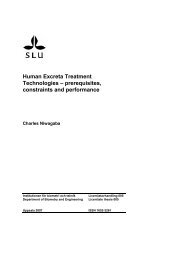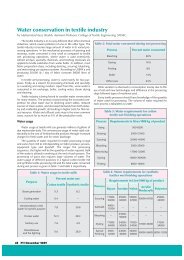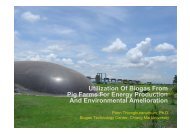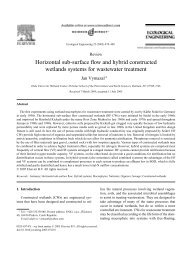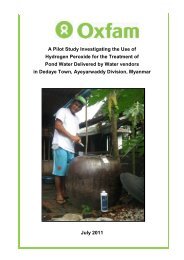Fertigation: Optimizing the Utilization of Water and Nutrients - SSWM
Fertigation: Optimizing the Utilization of Water and Nutrients - SSWM
Fertigation: Optimizing the Utilization of Water and Nutrients - SSWM
You also want an ePaper? Increase the reach of your titles
YUMPU automatically turns print PDFs into web optimized ePapers that Google loves.
Ecological Intensification <strong>of</strong> Agriculture <strong>and</strong> Implications for<br />
Improved <strong>Water</strong> <strong>and</strong> Nutrient Management<br />
Kenneth G. Cassman<br />
Department <strong>of</strong> Agronomy <strong>and</strong> Horticulture, University <strong>of</strong> Nebraska-‐Lincoln,<br />
Lincoln, NE 68583-‐0724, USA. E-‐mail: kcassman1@unl.edu.<br />
Abstract<br />
Econometric models predict that global cereal dem<strong>and</strong> will increase by 1.3%<br />
annually through 2025; cereal yields must increase by 1% annually to meet this<br />
dem<strong>and</strong>. This scenario assumes a 50-‐Mha increase in cereal production area.<br />
However, recent trends suggest that <strong>the</strong> cereal production area will stay<br />
constant, at best, or may decrease slightly because <strong>of</strong> l<strong>and</strong> conversion for o<strong>the</strong>r<br />
uses. Likewise, rising costs <strong>of</strong> fossil fuels are driving <strong>the</strong> diversion <strong>of</strong> grain for<br />
production <strong>of</strong> bi<strong>of</strong>uels <strong>and</strong> bio-‐based industrial feedstocks. It is, <strong>the</strong>refore,<br />
plausible that current econometric models underestimate cereal dem<strong>and</strong> <strong>and</strong> <strong>the</strong><br />
rate <strong>of</strong> yield increase that will be needed to meet it. The rate <strong>of</strong> increase in cereal<br />
yields is decidedly linear; it is falling below <strong>the</strong> rate <strong>of</strong> increase in dem<strong>and</strong>, <strong>and</strong><br />
would do so more rapidly under a scenario in which cereal dem<strong>and</strong> is greater<br />
<strong>and</strong> <strong>the</strong> cereal production area smaller than forecast by current econometric<br />
projections. There is a need for accelerated yield gain – combined with<br />
protection <strong>of</strong> natural resources <strong>and</strong> environmental quality for future generations.<br />
Ecological intensification <strong>of</strong> cereal production systems provides <strong>the</strong> framework<br />
for achieving <strong>the</strong>se dual goals. It involves concomitant improvements in nutrient<br />
use efficiency, especially <strong>of</strong> nitrogen (N), water use efficiency, <strong>and</strong> energy<br />
efficiency. <strong>Fertigation</strong> holds tremendous promise for contributing to ecological<br />
intensification in irrigated systems, because it facilitates improved congruence,<br />
in time <strong>and</strong> space, between crop nutrient dem<strong>and</strong> <strong>and</strong> <strong>the</strong> available nutrient<br />
supply. With advanced irrigation technology, such as low-‐pressure sprinkler<br />
systems or drip irrigation, fertigation can help sustain <strong>the</strong> required rate <strong>of</strong> yield<br />
gain while also achieving a substantial decrease in nutrient <strong>and</strong> water<br />
requirements per unit <strong>of</strong> grain production.<br />
Keywords: food security, crop yield potential, nutrient use efficiency,<br />
environmental quality, irrigated agriculture.<br />
23



